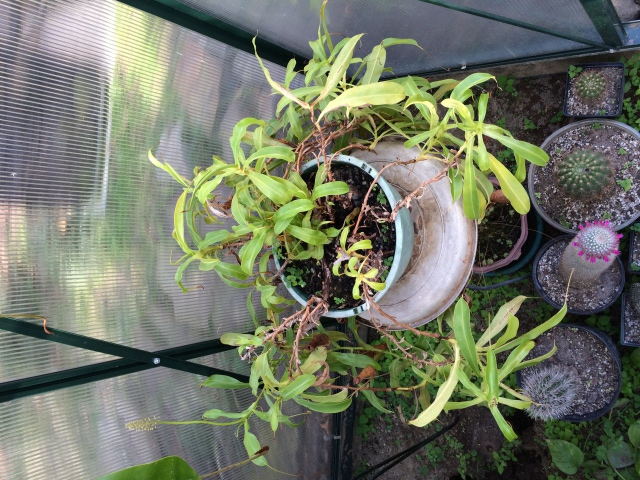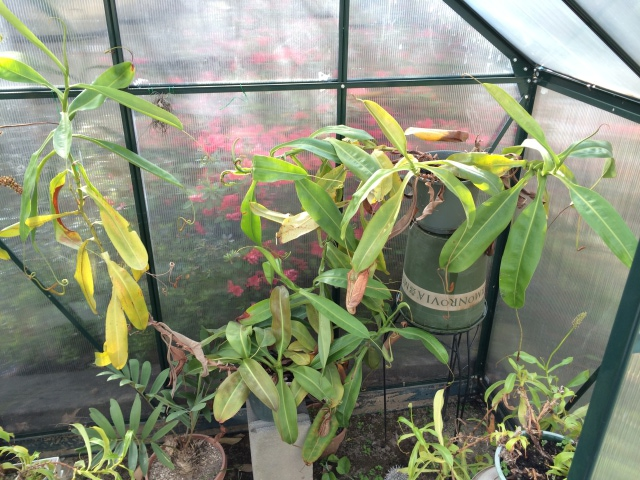Question
 Alata
Alata  Miranda
Miranda
Hi,
I've been growing Nepthenthes 'Miranda' and Nepenthese 'Alata' from Deroose Plants for about three years now. Both the leaves and pitchers have gotten smaller and lighter, especially on the 'Alata' which I've had 1/2 to 1 year longer. My question is: what can I do to get them to look like they did when I bought them? There are pictures on Deroose Plants' website incase you need a reference and I've included pictures. I live in central Alabama in zone 7b where I grow them outside during summer and in a greenhouse during winter. During summer they get morning light for a few hours then they are completely in shade until the late afternoon where they get filtered sunlight until sunset. In winter they get full sun throughout the day with a little shade for an hour or two around 12:00 or 1:00. I also have a heater set to keep the temperature between 45 and 80 during winter, and I take off all the panels of the greenhouse when the nights stay warmer than 50. I use R/O water directly on the soil, and honestly, maybe half of the time, the soil gets a little dry and the leaves may wilt slightly. The 'Alata' has been in the same 1:1:1 (roughly) ratio of peat, LFSM, and sand that I planted it in three years ago. I believe the 'Miranda' is in a 1:1 peat/sand mix that I planted it in 2-3 years ago. I don't use fertilizers or hard water (our water is 300+ppm here). I've trimmed both plants a few times but I hope that with a soil change into your recommended mix and trimming the plants down to the soil will help them come back to look more like what they did when I first got them. What do you think? Is trimming to the soil too extreme? And could I use diluted orchid fertilizer? If so, what kinds and what dilution? I especially need instructions on if, where, how close, and how much to trim.
Thank you for your time!
Preston
AnswerYes, you will need to pot your plants into fresh soil and trim the vines. This is the only way to encourage your plant to look like its former self. Smaller leaves can be a sign that the roots are becoming overcrowded, so you might need to use a larger pot. Smaller leaves can also be a sign that the soil had gotten bad, so you should definitely use a fresh soil mix. If your previous soil recipe had worked well for you, you can still use it. Nepenthes will tolerate various recipes as long as key factors are met. Given that you've grown yours in the mix for at least a couple years, you likely can stick with it.
It's beyond the scope of this format to describe how to transplant and trim your plant, but we do cover it in our Volume 3 DVD. Suffice to say that you should trim off all of the scraggly vines and keep only the shorter vines after you transplant your Nepenthes. As long as you maintain the shorter vines, cutting the longer vines closer to the soil won't pose a problem. (I do this a lot to our large specimens, and they grow back looking bushy.)
Don't worry about ferlizers for now. Focus on getting the plants into fresh soil and giving them a haircut. The roots will need time to recuperate before you add fertilizers.
For other soil recipes, watch our Volume 3 DVD or read the care guide online.
http://www.growcarnivorousplants.com/careguides
Good growing!
Jacob Farin







